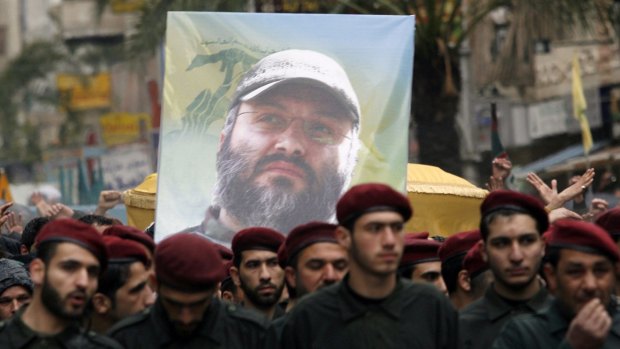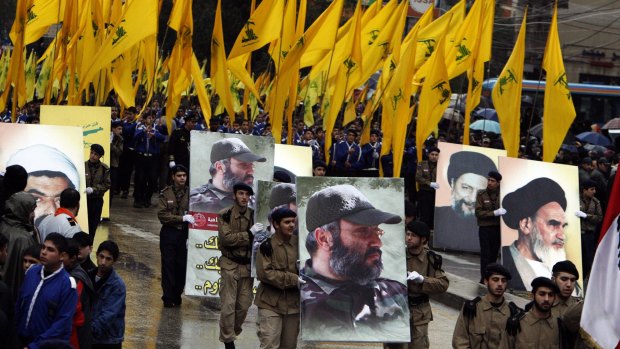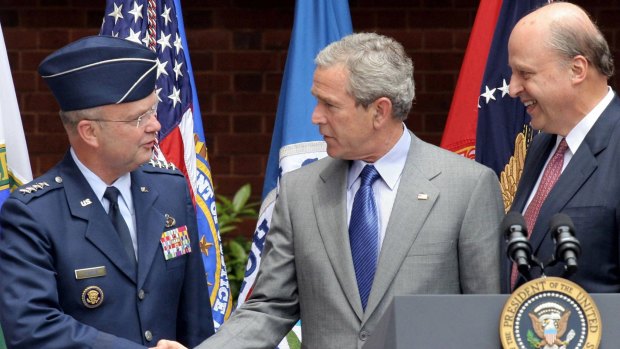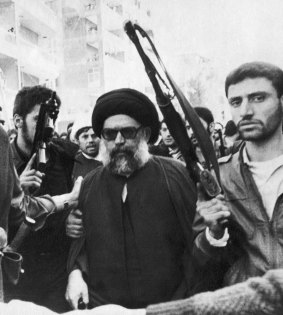This was published 9 years ago
CIA, Mossad killed senior Hezbollah figure in 2008 car bombing
By Adam Goldman
Washington: On February 12, 2008, Imad Mughniyah, Hezbollah's international operations chief, walked on a quiet nighttime street in Damascus after dinner at a nearby restaurant. Not far away, a team of CIA spotters in the Syrian capital was tracking his movements.
As Mughniyah approached a parked vehicle, a bomb planted in a spare tyre on the back exploded, sending a burst of shrapnel across a tight radius. He was killed instantly.

Hezbollah militants carry the coffin of slain commander Imad Mughniyah through the streets of Beirut in 2008.Credit: Reuters
The device was triggered remotely from Tel Aviv by agents with Mossad, the Israeli foreign intelligence service, who were in communication with the operatives on the ground in Damascus. "The way it was set up, the US could object and call it off, but it could not execute," said a former US intelligence official.
The United States helped build the bomb, the former official said, and tested it repeatedly at a CIA facility in North Carolina to ensure the potential blast area was contained and would not result in collateral damage.

The funeral march of assassinated Hezbollah leader Imad Mughniyah. His image is carried alongside those of Shiite clerics Ayatollah Ruhollah Khomeini, Musa Sadr and Ragheb Harb.Credit: AFP
The extraordinarily close cooperation between the US and Israeli intelligence services suggested the importance of the target - a man who over the years had been implicated in some of Hezbollah's most spectacular terrorist attacks, including those against the US Embassy in Beirut in 1983 and the Israeli Embassy in Argentina in 1992.
Washington has never acknowledged participation in the killing of Mughniyah, which Hezbollah blamed on Israel. US involvement in the killing, which was confirmed by five former US intelligence officials, also pushed American legal boundaries.
Mughniyah was targeted in a country where the US was not at war. Moreover, he was killed in a car bombing, a technique that some legal scholars see as a violation of international laws that proscribe "killing by perfidy" - using treacherous means to kill or wound an enemy.
"It is a killing method used by terrorists and gangsters," said Mary Ellen O'Connell, a professor of international law at the University of Notre Dame. "It violates one of the oldest battlefield rules."

US president George W. Bush shakes hands with Air Force General Michael Hayden, director of the CIA at the time of the Mughniyah assassination, in 2005. John Negroponte, then Director of National Intelligence, looks on.Credit: AFP
Former US officials, all of whom spoke on the condition of anonymity to discuss the operation, asserted that Mughniyah, although based in Syria, was directly connected to the arming and training of Shiite militias in Iraq that were targeting US forces.
The authority to kill Mughniyah required a presidential finding by George W. Bush. The attorney general, the director of national intelligence, the national security adviser and the Office of Legal Counsel at the Justice Department all signed off on the operation, one former intelligence official said.

Lebanese Shiite leader Mohammed Hussein Fadlallah is flanked by bodyguards in March 1985 as he attends a funeral ceremony in Beirut for more than 75 people killed in an attempt on his life. The attack is believed to have been carried out by Saudi agents at the CIA's instigation.Credit: AP
The CIA declined to comment.
"We have nothing to add at this time," said Mark Regev, chief spokesman for the prime minister of Israel.
A former US official said the Bush administration relied on a theory of national self-defence to kill Mughniyah, claiming he was a lawful target because he was actively plotting against the United States or its forces in Iraq, making him a continued and imminent threat who could not be captured. Such a legal rationale would have allowed the CIA to avoid violating the 1981 blanket ban on assassinations in Executive Order 12333. The order does not define assassination.
In sanctioning a 2011 operation to kill Anwar al-Awlaki, a US citizen and influential propaganda leader for al-Qaeda's affiliate in Yemen, the Justice Department made a similar argument.
In his 1987 book Veil, Washington Post journalist Bob Woodward reported that CIA director William Casey encouraged the Saudis to sponsor an attempt to kill a Hezbollah leader. The 1985 attempt on the life of Mohammed Hussein Fadlallah with a car bomb failed, but killed 80 people. Mughniyah's brother was among those killed.
Former agency officials said Mughniyah was involved in the 1984 kidnapping and torture of the CIA's station chief in Lebanon, William Buckley. The officials said Mughniyah arranged for videotapes of the brutal interrogation sessions of Buckley to be sent to the agency. Buckley was later killed.
Mughniyah was indicted in US federal court in the 1985 hijacking of TWA Flight 847 shortly after it took off from Athens and the slaying of US Navy diver Robert Stethem, a passenger on the plane. He was also suspected of involvement by US intelligence and law enforcement officials in the planning of the 1996 Khobar Towers bombing in Saudi Arabia that killed 19 US servicemen.
The Bush administration regarded Hezbollah - Mughniyah, in particular - as a threat to the United States. In 2008, several months after he was killed, Michael Chertoff, then secretary of homeland security, said Hezbollah was a threat to national security. "To be honest, they make al-Qaeda look like a minor league team," he said.
During the operation, one former official claims, the CIA and Mossad had a chance to kill Major-General Qasim Suleimani, commander of Iran's paramilitary Quds Force, as he and Mughniyah walked together.
"At one point, the two men were standing there, same place, same street. All they had to do was push the button," the official said. But the operatives didn't have the legal authority to kill General Suleimani - there had been no presidential finding to do so.
At the time of the assassination, State Department spokesman Sean McCormack said: "The world is a better place without this man in it. He was a coldblooded killer, a mass murderer and a terrorist responsible for countless innocent lives lost."
Inside the intelligence community, a former official recalled, "It wasn't jubilation."
"We did what we had to," the official said, "and let's move on."
Washington Post